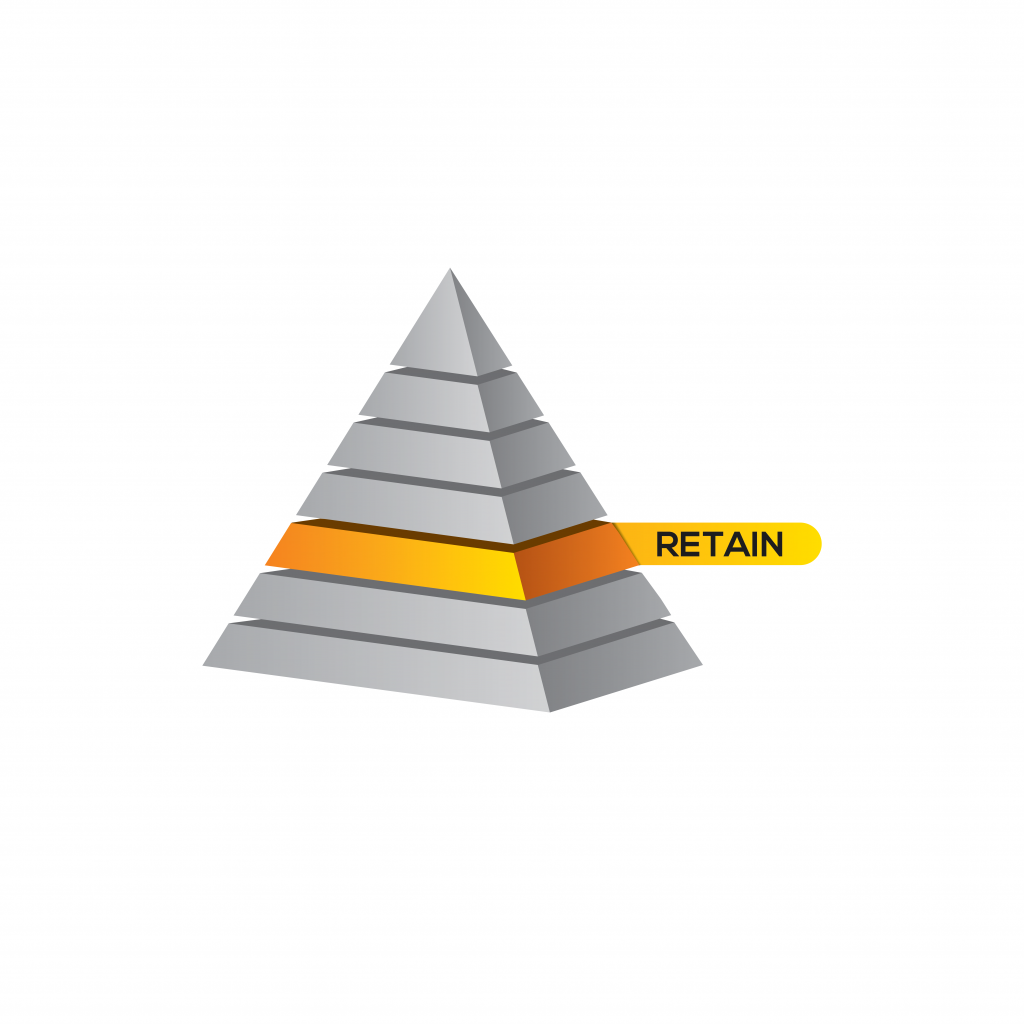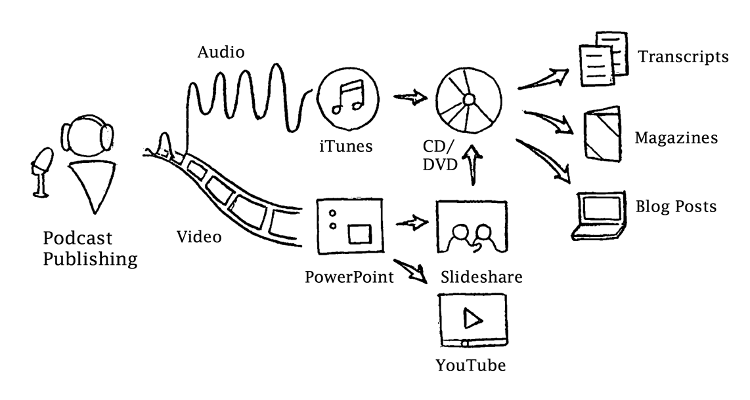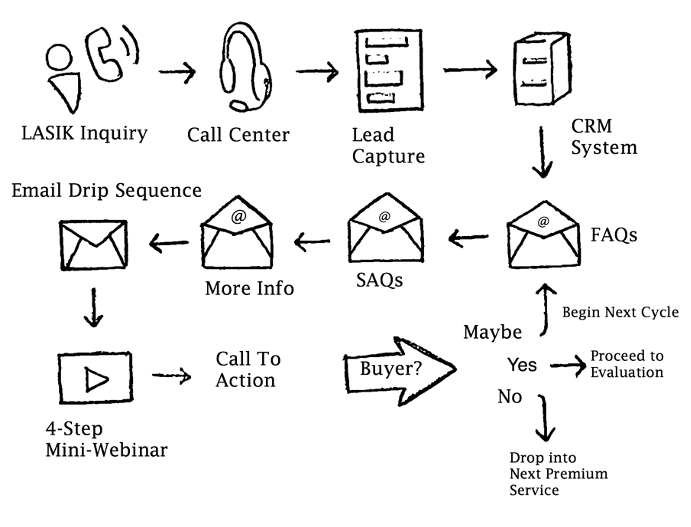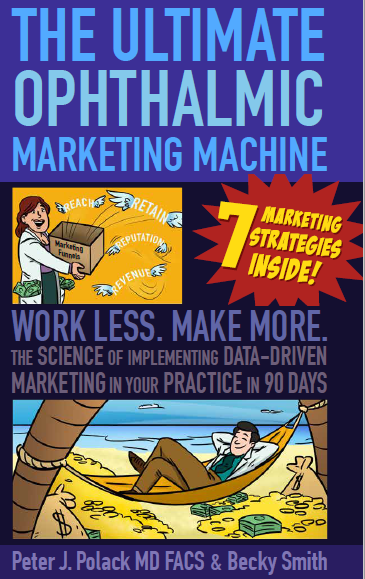Retention of established patients can (almost) be done on auto-pilot. The purpose of retention (the 3rd of our 7 R's) is, obviously, to extend the customer lifecycle (and customer lifetime value). The reason this strategy is underutilized is that many ophthalmologists assume they’ll see patients when they come back for their annual exam. However, statistics you may be familiar with show that only about 50% of your patients come in regularly each year, so this works out to 'annual' exams averaging only every other year.

What if you could move the percentage of patients faithfully coming in annually from 50% to 80%? Well, you do the math. And you really don’t need to do much to set up a process that works to improve this number. What you do need to do is build a relationship that lowers resistance to annual visits.
"Retention is the new acquisition.”

Dan kennedy | direct marketing guru
Retention funnels are easy to set up and easy to automate. Once they are in place, they do the work for you. For this reason, retention is truly the low-hanging fruit when it comes to marketing. Patients are very happy to receive information from your practice, both digitally and physically (USPS 'snail mail').
Themed Direct Mail Funnel
One of the most effective funnels is a campaign that is laid out a year at a time with a calendar, with content and messages each month with holiday themes – for example, “A New Year is starting, let’s get off to a fresh start.” It can be a newsletter or a postcard, something that gives you a reason to be in a patient’s mailbox. It provides patient education and some content that’s entertaining, not necessarily just promoting “Get two-for-one glasses this week.” It’s a touch that is consistently executed.
Done properly, these direct mail touches should deliver a mix of education and entertainment with the occasional promotional offer, so as not to overwhelm your patients with sales pitches. Most people don’t mind being offered great promotions if they perceive these monthly contacts as not too “salesy” – more about keeping in touch with relevant information that just happens to include a great offer.

Themed direct mail funnel: Promotions are based on monthly themes, such as holidays, and sent out on postcards using the practice’s internal mailing list (for retention) or geographic “farming” in the form of the USPS EDDM (Every Door Direct Mail) service (for recruiting new patients)
Chairside Marketing Funnel
The second funnel that you can use to retain patients is something we call chairside marketing. At the end of the patient visit, you hand them a little packet. We recommend it include a “Thank You” card that’s a gift coupon or voucher and a brief personal note from the physician (not the practice – keep it one to one). It’s something small, but it matters to the patient. You may want to consider adding a second coupon or voucher, a “Gift for a Friend,” that they can give to a friend or family member. This gift becomes their referral and transitions from expanding wallet share (Thank You gift) into expanding market share (A Gift for a Friend). They’re referring someone as a new patient.
New Patient Thank You Package Funnel
A third retention funnel comes into play at the very beginning of the relationship. When a new patient comes in for their first exam, you can give them a package containing lots of little things that let them get to know you better: a video book with content showcasing your services, some samples of eye drops, or a face mask that they can put in the fridge and place on their puffy eyes before they go to work – something that is big enough to look and feel like a gift box. Alternatively, it can be sent to them prior to their first visit (welcome package).
This package not only lets them know you are happy that they’ve come to you, but also reminds them and educates them about the services that they can turn to you for (and that perhaps they didn’t realize you were capable of doing for them).
Practice Publishing Funnel
One very cost-effective funnel that works for retention is practice publishing. It might sound like a large and expensive undertaking, but with current technology, your marketing operations department has many ways of taking the content you produce and repurposing it, republishing it, and syndicating it across multiple channels for consumer consumption.
For example, a practice might have thought about producing a podcast and stopped there. But let’s say you’ve got an interesting topic (or even a whole calendar of topics). Here’s a simple process for practice publishing.
First, a podcast is recorded in which a host (like your marketing person) interviews the doctor about their unique techniques or experiences with a certain patient population. These podcasts are captured as audio files and published to a podcast service, such as iTunes, or hosted and streamed from the practice website.
But don’t stop there.

A plethora of content assets can be produced from a single, inexpensively produced podcast, from print to audio to video
Practice publishing takes that simple 10-minute interview and produces lots of other types of content that are consumed by various audiences in different formats.
The process that we recommend is called a one-to-many podcast content marketing strategy.
- Have your podcast transcribed.
- That transcript becomes an article.
- It also becomes a blog post.
- By taking snippets of content, that transcript is then turned into slides and text for a PowerPoint show.
- PowerPoint files can be published and syndicated on SlideShare.com.
- That PowerPoint show can be turned into a video, with audio synchronized with the slides. That video then becomes an asset published on YouTube, Vimeo, Wistia, or other video sharing sites with links back to your practice website. You now have three or four different syndication services that you can use, and you can publish the content to your Facebook page, LinkedIn profile, or Google Business Page; you can Tweet about it and post it to social bookmarking sites such as Tumblr. This is really just a content repurposing exercise. You are not having to generate new content for each of these distribution channels.
- Next, you can take several podcast transcripts and assemble them into a digest or a magazine showcasing “The top trends in our practice that make your life easier today.” Think of this as a periodical that you could do quarterly. Just hire a graphic artist to create a magazine cover with a headline, think of a theme for the digest, write some copy teasers to make your audience want to read it, and maybe design and create content for a back cover. Promote an offer or two in the inside front and back covers. Pepper it with ads for different premium services and be sure to come up with a compelling call to action.
Now you’ve got both a digital marketing communique and a waiting room piece, all based on content that you captured in a few 10-minute podcasts.
Email Drip Campaign Funnel
The last retention funnel that we’ll mention is called an email drip campaign. Emails are dripped out over a certain period to your inhouse marketing email list. Remember that, under HIPAA, you have to get permission (opt-in) from the patient for you to market to them. This is a separate email list from the one you use to send practice-related communications such as billing notices or appointment reminders. And these two lists should not be merged. And established patients and prospective patients need to be on different email lists.
Once permission is obtained, you can create and then schedule emails that, for example, announce a lecture you’re giving or a seminar you’re holding. The email may invite patients to watch a video with relevant information before they come to the seminar. You can make a series of emails, or touches, on any topic you want, and you can cycle your patients through several different cash-pay services funnels introducing them to premium services available from your practice.
This figure shows an email drip campaign process flow for a LASIK inbound phone inquiry. We go into detail in the case study that follows.

LASIK education email drip campaign marketing funnel
Since LASIK is a scary and expensive proposition for most patients, they need time to become educated and to develop trust before making a decision. If they still show no interest, they can be automatically dropped into the next premium service drip campaign funnel.
The emails are automatically sent out at predetermined intervals using an autoresponder application, which will be described later (enabling technology). We recommend mixing education content with offers to take action so that in every fourth or fifth email there is a link to videos explaining in depth some of the information that has been presented to them. These videos can have interviews with the LASIK surgeons, a virtual tour of the facility, an interview with the refractive coordinator, and some testimonials from satisfied patients.
This gives the prospect an opportunity to have questions answered or objections addressed in a non-intimidating fashion and makes it more likely that they will feel comfortable scheduling an evaluation. Content delivered via an automated follow-up system ensures development of a relationship first (nurturing). It also makes sure prospects don’t slip through the cracks.
Take the time to design a proper funnel for each R strategy. What is the path that a prospective patient takes from first contact to completion of a procedure or service?
Case Study: LASIK Education Email Drip Campaign Marketing Funnel
Patients who call into a practice seeking information about LASIK may not be ready quite yet to schedule their procedure and might feel intimidated if they feel they have to make an appointment on their first inquiry call. They may prefer just to receive some information. This is why putting a "Schedule Your Consultation" button on your homepage is unlikely to convert very highly.
So, you’ve got some trust-building to do. But without collecting their contact information when they inquire and dropping them into a marketing funnel, simply answering questions on the phone could result in a lost opportunity.
The call center or receptionist should ask for their email in order to send them more information. After their email address has been added to a LASIK inquiry list, they will begin to receive a 'drip sequence' of emails that contain information addressing frequently asked questions (FAQs) about the LASIK procedure: What is it? Who is it for? What are some pros and cons? How does it compare with other refractive procedures? What are inclusion and exclusion criteria? What is the next step?
Not only does this allay their fears and address their potential objections, when they do come in they will already be fairly pre-educated about the procedure. This will cut down on unnecessary staff and doctor face time.
FUEL: Follow Up Every Lead
As we mention in our LASIK marketing case study, not everyone is ready to book surgery or make a purchase right from the get-go. In fact, probably only 2% of people who inquire are ready to buy within the next 10 days. Over time, the other 98%, if you keep them from shopping elsewhere, will turn to you when their readiness has matured.
“Follow Up Every Lead” puts opportunities in a place where you can 'touch' them in educational and entertaining ways while building your reputation, authority, and credibility (ACE). Once you become a trusted advisor, you are the go-to person in their mind. This is separate from brand recognition (where most practices concentrate their resources), which just means “Oh yeah, I’ve heard of those guys.”
Key Takeaways:
- Retention can be simple and inexpensive but it is underutilized by most practices
- The most effective way to get patients to raise their hands for a service or procedure is to establish and maintain an ongoing relationship with them (what is known as nurturing)
- You can’t maintain an ongoing relationship with a patient unless you establish a process for collecting every patient’s contact information whenever possible
- Nurturing also makes patients aware of all of the other services that your practice offers, so you avoid having your cataract surgery patients go elsewhere for their bleph surgery because they "didn't know you did that!"

